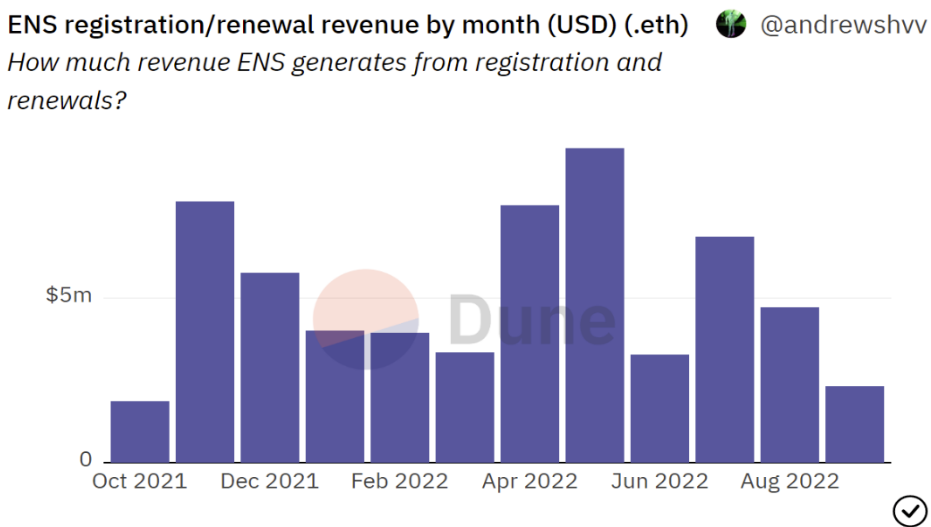Original link: https://www.hellobtc.com/kp/du/09/4005.html
Author: Terry / Source: Vernacular Blockchain

Author | Terry
Produced | Vernacular Blockchain (ID: helloBTC)
If you want to ask what topic is the most discussed recently, it is naturally the Ethereum domain name service ENS. Since April this year, the ENS domain name that was rarely used by people has quickly ushered in a wave of registrations, from the initial 1000 three-digit ENS, to With more 4-digit numbers and 5-digit numbers, along with the market’s enthusiasm for buying out and stockpiling goods, the market began to gradually rush to squat and sweep the goods, and the floor price rose to a new level almost every day.
And this wind is still accelerating to the inside and outside of the circle. Not long ago, Nick Tomaino, the founding partner of the venture capital institution 1confirmation, changed his Twitter nickname to “1492.eth” and said “In 1492, Columbus began his first voyage. “.

01
ENS dances, followed by “.BNB”, “.bit”, etc.
If you look at the data level, the total protocol revenue of ENS since its establishment is about 61.5 million US dollars, and the protocol revenue from 2022 to the present has reached nearly 46 million US dollars, that is, since ENS was launched in 2017, about 75% of the revenue has been earned this year. arrived.
Among them, the registration (renewal) revenue of ENS in May this year reached 9.56 million US dollars, and the registration (renewal) revenue of the Ethereum domain name service ENS in April reached 7.83 million US dollars, ranking first and third in monthly agreement revenue. Only the historical monthly revenue of $7.93 million in November 2021 was in the top three for several years.

However, after June, ENS has cooled down for a while, and the protocol revenue has declined significantly, but recently the popularity has obviously started to pick up :
ENS registered more than 300,000 new domain names in August, the total number of domain names reached 2.17 million, and the agreement revenue reached 4.7 million US dollars; but as of September, less than two weeks have passed, it has already generated 2.32 million US dollars of agreement revenue, according to This momentum beyond August or even July data is a certainty.
As ENS ignites domain name services, recently, Web3 domain name projects based on other public chains have also begun to receive widespread market attention. Among them, SPACE ID, which completed the seed round financing led by Binance Labs on September 2, is even more popular.
According to Dune data, the current average registration cost of SPACE ID is only 0.0418 BNB. The official also stated last week that “due to receiving a lot of feedback from the community on the staged registration of .bnb domain names, it was decided to postpone the staged registration to next week.”

According to the data of Nervos ecological Web3 identity protocol “.bit” (formerly DAS) on September 15, the number of single-day registrations exceeded a new high for 3 consecutive days, with a total of 138,000 registered accounts and 48,000 independent registered addresses.
02
“.com” and user business cards in the Web3 era?
The growing popularity of Web3 Domain Name Service is inseparable from its attributes as a Web3 infrastructure.
On the one hand, it has almost become standard for project parties in the crypto world to purchase the ENS domain name of the corresponding project brand (including the recent Project Galaxy changed its name to Galxe, and it is suspected that the project party has completed the squatting in the ENS domain name in advance), even the traditional Web2 project Fang also began to purchase the corresponding ENS domain name:
Budweiser bought beer.eth for 30 ETH; luxury brand Gucci bought gucci.eth for 12 ETH; jewelry brand Tiffany bought the tiffany.eth domain name for 29 ETH.
On the other hand, because the ENS domain name supports DIY registration and creation, and can simplify the representation of the user’s blockchain address, so as to set a recognizable on-chain name like Twitter and other social media, it is often regarded as Personal on-chain business cards in the Web3 era.
Like vitalik.eth of Ethereum co-founder Vitalik, terence.eth of Ethereum core developer Tim Beiko, etc.

And due to the unique displayable identity attributes, ENS special characters (123.eth, abc.eth, etc.) with special meaning or intuitive memory like mobile phone numbers are also easy to usher in a wave of hype.
At the beginning of the birth of Web2 domain names, many well-known entrepreneurs made their first pot of gold by selling domain names. For example, Yao Jinbo, the founder of 58.com, founded the domain name trading website “Easy Domain” and made a fortune by selling domain names.
Compared with the traditional “.com”, the Web3 domain name service represented by ENS has stronger individual characteristics and has its own social attributes:
Users can set and display personal information in the domain name they hold, such as other addresses such as Bitcoin, Litecoin or Dogecoin, as well as email addresses, URL links (Uniform Resource Locator, which is the address of standard resources on the Internet), Twitter name , and information on Github, Reddit, Telegram, etc., and even add NFT avatars.
At present, in the Ethereum ecosystem, more and more protocols have begun to support ENS, using ENS as a name, using NFT as an avatar, using mirror to record life, and using AR to store content. The foundation of Web3.0 social applications.
To a certain extent, in the more than 5 years since its launch, ENS has gradually developed from the original Ethereum address resolution to the business card of the Web3 world, and with the development and adoption of ENS and the transformation of Web3, it is very likely to become Web3 core infrastructure.
The same is true for the current development trend of Web3 domain name services. In fact, it is far from enough to only do business of brand development or personal business cards.
03
Web3 identity ambitions for domains like ENS
Therefore, domain name service projects such as ENS are basically turning to the Web3 identity system. On March 8 this year, the original DAS brand was officially renamed and upgraded to “.bit”, evolving from a pure domain name agreement to a cross-chain decentralized identity (DID). )system.
In short, they have all begun to become more and more key carriers of user digital identity in the Web3 era, thus forming a set of cross-chain decentralized identity (DID) systems.
DID is widely regarded as the core infrastructure of Web3, and the core essence is to truly hand over personal privacy and data rights to everyone’s free control.
Because in the traditional account system, the current Internet giants hold the privacy and data that should belong to users, but they go to financing, listing, and other commercial activities, but users as contributors do not enjoy due returns.
And DID gives a corresponding identity to Web3 users in the blockchain world. In the traditional Internet world, we are already familiar with Internet identities such as mobile phones, Weibo, WeChat, etc. that exist in the form of accounts. These identities divided into different ecological segments are managed and preserved by corresponding centralized Internet service providers. Therefore, the corresponding hidden dangers of centralization cannot be avoided.
DID, on the other hand, uses technologies such as blockchain to realize that digital identities are truly owned and controlled by each user, which is the identity credential in a decentralized society in the future.
Just like we keep paper documents such as ID cards, passports, and household registration books in our own homes and keep them carefully, and only take them out when needed, there is no longer any middleman who completely owns the user’s identity and data, which can be better avoided. the predicament.
For example, any user can register an ENS or other public chain domain name service account without permission. Once the registration is successful, you (and only you) will have complete control over the account, and an account corresponds to several addresses under the personal identity ( Including BTC, ETH, etc.), the most direct, after binding your personal identity, you can complete the transfer of multi-chain assets only by entering “terry.eth” and other similar abbreviations.
In addition, not only limited to the blockchain, any data that is willing to be disclosed, such as personal social accounts, email addresses, personal profiles, personal preferences, etc., can be added to the DID account with ENS as the carrier, and everyone can have a Thoroughly censorship-resistant personal information homepage.
This is equivalent to having a relatively comprehensive identity system – it also means that “big data portraits” of individuals can be carried out, not only limited to on-chain asset records, but also derived from on-chain + off-chain credit assessments, which can be said to be on-chain and off-chain. “Sesame Credit System” on .
That is to say, with the help of the DID account with ENS as the carrier, the data on and off the chain can be opened up, and the credit factor and even a complete set of credit mechanism can be introduced into the Web3 world.
This is also the greater possibility that domain name services such as ENS can bring to the world of DID and Web3 in the future.
This article is reprinted from: https://www.hellobtc.com/kp/du/09/4005.html
This site is for inclusion only, and the copyright belongs to the original author.